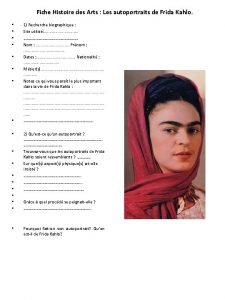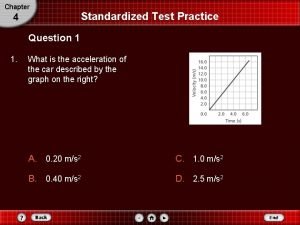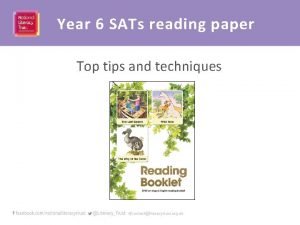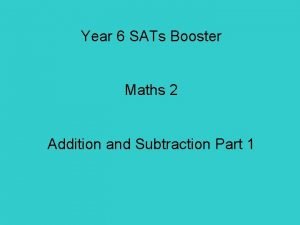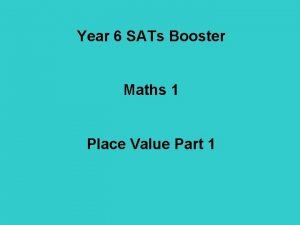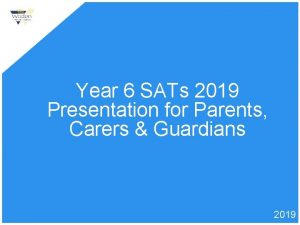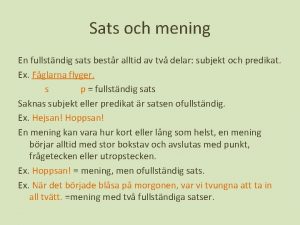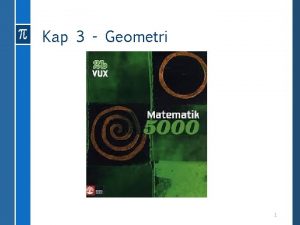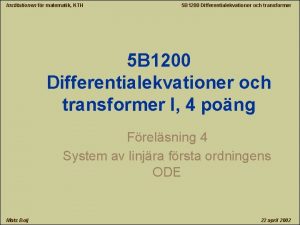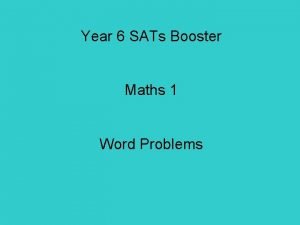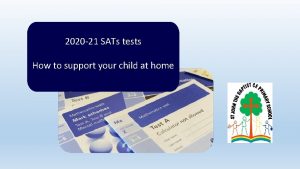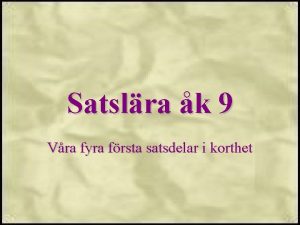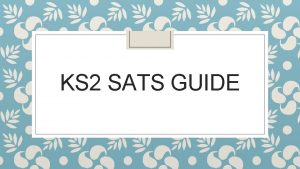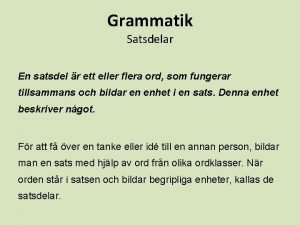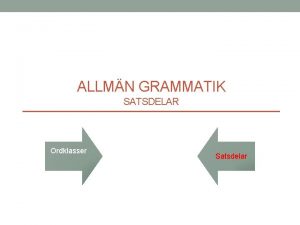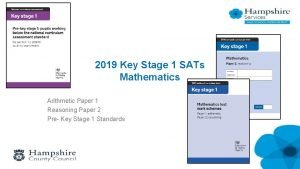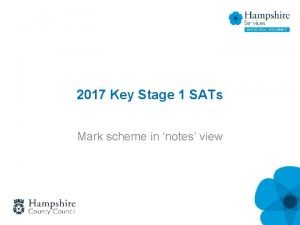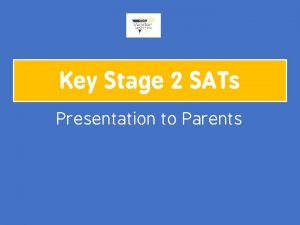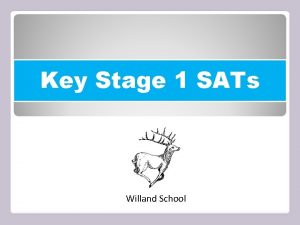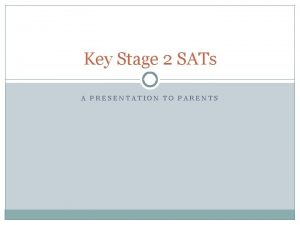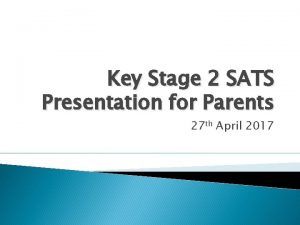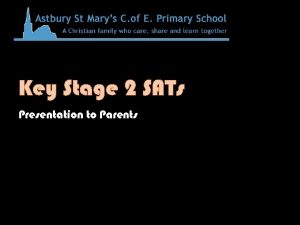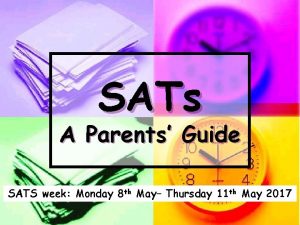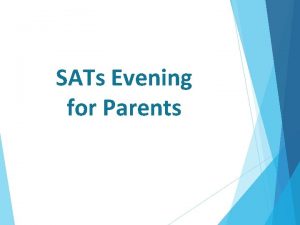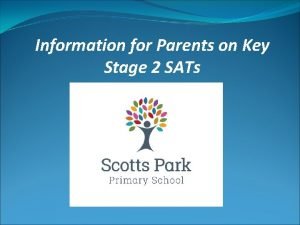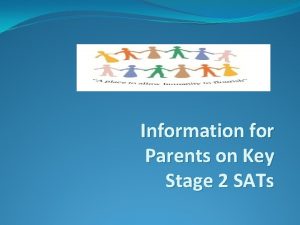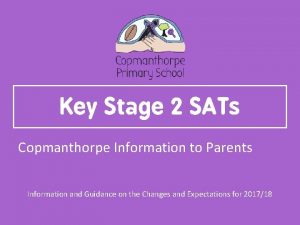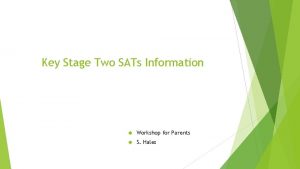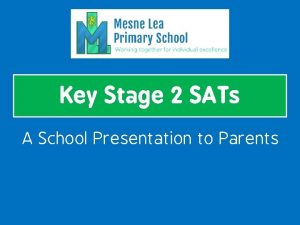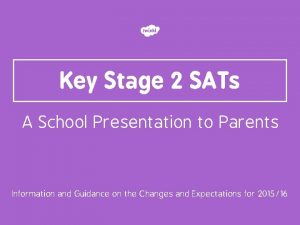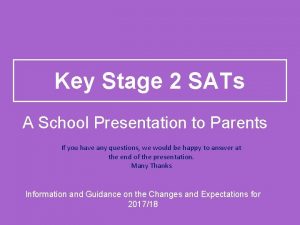Key Stage 2 SATs Presentation to Parents Chapters























- Slides: 23

Key Stage 2 SATs Presentation to Parents

Chapters Assessment and Reporting Science Scaled Scores Scaled Score Examples Higher-Attaining Pupils The Tests English Maths How to Help Your Child next page

Assessment and Reporting • As of 2014, the ‘old’ national curriculum levels (e. g. level 3, 4, 5) were abolished as set out in government guidelines. • The 2014 curriculum is rigorous and sets noticeably higher expectations than previous curricula, which is why all schools have had to work hard to meet and adapt to it since its introduction. • Since 2016, test scores have been reported as ‘scaled scores’. chapter menu next page

Scaled Scores What is meant by ‘scaled scores’? • It is planned that 100 will always represent the ‘national standard’. • Each pupil’s raw test score will therefore be converted into a score on the scale, either at, above or below 100. • The scale will have a lower end point somewhere below 100 and an upper end point above 100. • A child who achieves the ‘national standard’ (a score of 100) will be judged to have demonstrated sufficient knowledge in the areas assessed by the tests. • Each pupil receives: o a raw score (number of raw marks awarded); o a scaled score in each tested subject; o confirmation of whether or not they attained the national standard. chapter menu next page

Scaled Score Examples On publication of the test results in July: • a child awarded a scaled score of 100 is judged to have met the ‘national standard’ in the area judged by the test; • a child awarded a scaled score of more than 100 is judged to have exceeded the national standard and demonstrated a higher than expected knowledge of the curriculum for their age; • a child awarded a scaled score of less than 100 is judged to have not yet met the national standard and performed below the expectation for their age. chapter menu next page

Higher-Attaining Pupils • In the past, Key Stage 2 tests were aimed at children achieving levels 3 -5 (with a national expectation to reach at least level 4). • This meant that additional level 6 tests were produced for children who demonstrated higher than expected attainment (above level 5). • Under the new system, there are not any separate tests for the most-able children. • Instead, each test will have scope for higher-attaining pupils to show their strengths. • This means that some questions towards the end of the tests may be more difficult for many children but they should be encouraged to attempt as much of the test as they are able to. chapter menu next page

The Tests Key Stage 2 SATs take place nationally in the week commencing Monday 13 th May 2019 Statutory tests will be administered in the following subjects: o Punctuation, Vocabulary and Grammar (45 minutes) o Spelling (approximately 15 minutes) o Reading (60 minutes) o Mathematics - Paper 1: Arithmetic (30 minutes) - Paper 2: Reasoning (40 minutes) - Paper 3: Reasoning (40 minutes) • The biennial science sampling tests will take place in 2020, so we do not have this to consider. • All tests are externally marked. chapter • As in recent years, writing will be teacher assessed internally. The revised ‘pupil can’ menu statements for English writing place a greater emphasis on composition and the statements that relate to the more ‘technical’ aspects of English writing (grammar, punctuation and spelling) have been made less prescriptive. next page

Reading • The reading test consists of a single test paper with three unrelated reading texts. Children are given 60 minutes in total, which includes reading the texts and answering the questions. • A total of 50 marks are available. • Questions are designed to assess the comprehension and understanding of a child’s reading. • During the reading paper, a child’s inference and deduction skills are thoroughly tested. They will also be expected to answer questions on authorial choices: explaining why an author has chosen to use particular vocabulary, grammar and text features. • Some questions are multiple choice or selected response; others require short answers and some require an extended response or explanation. chapter menu next page

Sample Questions Reading Paper chapter menu next page

Sample Questions Reading Paper chapter menu next page

Grammar, Punctuation & Spelling • A spelling test is administered containing 20 words, which lasts approximately 15 minutes. • A separate test is given on grammar, punctuation and vocabulary. • This test lasts for 45 minutes and requires short answer questions including some multiple choice. • Marks for these two tests are added together to give a total for grammar, punctuation and spelling. chapter menu next page

Sample Questions Grammar, Punctuation and Spelling Paper 1 chapter menu next page

Sample Questions Grammar, Punctuation and Spelling Paper 1 chapter menu next page

Mathematics • The mathematics tests have undergone the biggest change in recent years. • Children will sit three tests: paper 1, paper 2 and paper 3. • Paper 1 is for arithmetic lasting for 30 minutes, covering calculation methods for all operations, including use of fractions, percentages and decimals. • Questions gradually increase in difficulty. Not all children will be expected to access some of the more difficult questions later in the paper. • Papers 2 and 3 cover problem solving and reasoning, each lasting for 40 minutes. chapter menu • Pupils will still require calculation skills but will need to answer questions in context and decide what is required to find a solution. next page

Sample Questions Maths Paper 1: Arithmetic chapter menu next page

Sample Questions Maths Paper 2 / Paper 3 : Reasoning chapter menu next page

Sample Questions Maths Paper 2 / Paper 3 : Reasoning chapter menu next page

Science • A selection of schools will be chosen to take part in the science sampling tests in June 2020. • The tests will be administered in selected schools by external administrators. The tests will only be taken by 5 pupils in each of these schools. • There are three papers (25 minutes each). • Science sampling test results will be reported as national data only. No individual school or pupil will be identified within the data that is published and individual results will not be returned to schools or pupils. chapter menu next page

How to Help Your Child • First and foremost, support and reassure your child that there is nothing to worry about and they should always just try their best. Praise and encourage! • Ensure your child has the best possible attendance at school. • Support your child with any homework tasks. • Reading, spelling and arithmetic (e. g. times tables) are always good to practise. • Talk to your child about what they have learnt at school and what book(s) they are reading (the character, the plot, their opinion). • Make sure your child has a good sleep and healthy breakfast every morning! chapter menu next page

How to Help Your Child with Reading • Listening to your child read can take many forms. • First and foremost, focus developing an enjoyment and love of reading. • Enjoy stories together – reading stories to your child at KS 1 and KS 2 is equally as important as listening to your child read. • Read a little at a time but often, rather than rarely but for long periods of time! • Talk about the story before, during and afterwards – discuss the plot, the characters, their feelings and actions, how it makes you feel, predict what will happen and encourage your child to have their own opinions. • Look up definitions of words together – you could use a dictionary, the Internet or an app on a phone or tablet. • All reading is valuable – it doesn’t have to be just stories. Reading can involve anything: fiction, chapter menu non-fiction, poetry, newspapers, magazines, football programmes and TV guides. • Visit the local library - it’s free! next page

How to Help Your Child with Writing • Practise and learn weekly spelling lists – make it fun! • Encourage opportunities for writing such as letters to family or friends, shopping lists, notes or reminders, stories and poems. • Write together – be a good role model for writing. • Encourage use of a dictionary to check spelling and a thesaurus to find synonyms and expand vocabulary. • Allow your child to use a computer for word processing, which will allow for editing and correcting of errors without lots of crossing out. • Remember that good readers become good writers! Identify good writing features chapter when reading (e. g. vocabulary, sentence structure and punctuation). menu • Show your appreciation: praise and encourage, even for small successes! next page

How to Help Your Child with Maths • Play times tables games. • Play mental maths games including counting in different amounts, forwards and backwards. • Encourage opportunities for telling the time. • Encourage opportunities for counting coins and money; finding amounts or calculating change when shopping. • Look for numbers on street signs, car registrations and anywhere else! • Look for examples of 2 D and 3 D shapes around the home. • Identify, weigh or measure quantities and amounts in the kitchen or in recipes. • Play games involving numbers or logic, such as dominoes, card games, darts, draughts and chess. chapter menu next page

 Mes grands-parents mes parents et moi frida kahlo
Mes grands-parents mes parents et moi frida kahlo Parents parents
Parents parents Autoportraits de frida kahlo
Autoportraits de frida kahlo 4-4 standardized test prep answers
4-4 standardized test prep answers To kill a mockingbird chapter 1 questions
To kill a mockingbird chapter 1 questions Sats reading paper tips
Sats reading paper tips Sats booster maths
Sats booster maths Sats booster maths
Sats booster maths Year 6 sats papers 2019
Year 6 sats papers 2019 Year 6 sats 2019
Year 6 sats 2019 Sats week
Sats week Predikatsfyllnad exempel
Predikatsfyllnad exempel Steiner's theorem
Steiner's theorem Parallelltransversal
Parallelltransversal Fundamentalmatris
Fundamentalmatris Zids and zods answers
Zids and zods answers Sats revision timetable
Sats revision timetable Sats tests 2020
Sats tests 2020 Ofullständig sats
Ofullständig sats What are sats
What are sats Predikatfyllnad
Predikatfyllnad Emfas synonym
Emfas synonym Sats papers 2019
Sats papers 2019 2017 arithmetic paper mark scheme
2017 arithmetic paper mark scheme


